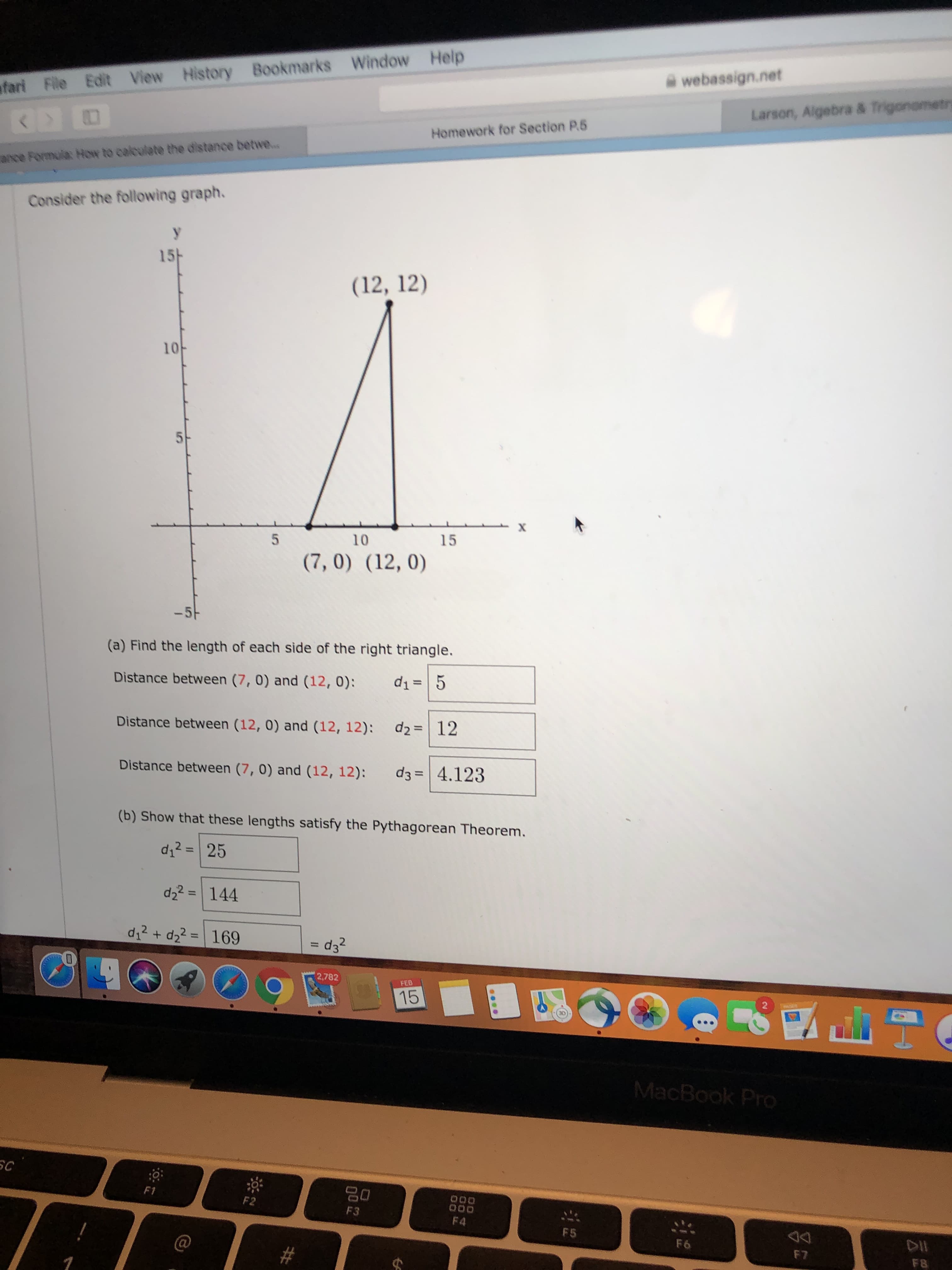File Edit View History Bookmarks Window Help " webassign.net fari Larson, Algebra & Homework for Section P6 ance Formula How to caloulete the distance betwe Consider the following graph. 바 15 (12, 12) 10 10 15 (7, 0) (12, 0) (a) Find the length of each side of the right triangle Distance between (7, 0) and (12,0): d Distance between (12, 0) and (12, 12): d2 12 Distance between (7, 0) and (12, 12): d34.123 5 (b) Show that these lengths satisfy the Pythagorean Theorem d2 25 df= | 144 d12 d22169 2 3 2,782 FED 15 SC F3 F4 F5 F7 F 8
File Edit View History Bookmarks Window Help " webassign.net fari Larson, Algebra & Homework for Section P6 ance Formula How to caloulete the distance betwe Consider the following graph. 바 15 (12, 12) 10 10 15 (7, 0) (12, 0) (a) Find the length of each side of the right triangle Distance between (7, 0) and (12,0): d Distance between (12, 0) and (12, 12): d2 12 Distance between (7, 0) and (12, 12): d34.123 5 (b) Show that these lengths satisfy the Pythagorean Theorem d2 25 df= | 144 d12 d22169 2 3 2,782 FED 15 SC F3 F4 F5 F7 F 8
Holt Mcdougal Larson Pre-algebra: Student Edition 2012
1st Edition
ISBN:9780547587776
Author:HOLT MCDOUGAL
Publisher:HOLT MCDOUGAL
Chapter12: Angle Relationships And Transformations
Section12.5: Reflections And Symmetry
Problem 20E
Related questions
Topic Video
Question
I need help with my homework. I just need someone to confirm if I’m doing it right

Transcribed Image Text:File Edit View History Bookmarks Window Help
" webassign.net
fari
Larson, Algebra &
Homework for Section P6
ance Formula How to caloulete the distance betwe
Consider the following graph.
바
15
(12, 12)
10
10
15
(7, 0) (12, 0)
(a) Find the length of each side of the right triangle
Distance between (7, 0) and (12,0): d
Distance between (12, 0) and (12, 12): d2 12
Distance between (7, 0) and (12, 12): d34.123
5
(b) Show that these lengths satisfy the Pythagorean Theorem
d2 25
df= | 144
d12 d22169
2
3
2,782
FED
15
SC
F3
F4
F5
F7
F 8
Expert Solution
This question has been solved!
Explore an expertly crafted, step-by-step solution for a thorough understanding of key concepts.
This is a popular solution!
Step 1
VIEWTrending now
This is a popular solution!
Step by step
Solved in 1 steps with 1 images

Knowledge Booster
Learn more about
Need a deep-dive on the concept behind this application? Look no further. Learn more about this topic, calculus and related others by exploring similar questions and additional content below.Recommended textbooks for you

Holt Mcdougal Larson Pre-algebra: Student Edition…
Algebra
ISBN:
9780547587776
Author:
HOLT MCDOUGAL
Publisher:
HOLT MCDOUGAL

Algebra & Trigonometry with Analytic Geometry
Algebra
ISBN:
9781133382119
Author:
Swokowski
Publisher:
Cengage

Elementary Geometry For College Students, 7e
Geometry
ISBN:
9781337614085
Author:
Alexander, Daniel C.; Koeberlein, Geralyn M.
Publisher:
Cengage,

Holt Mcdougal Larson Pre-algebra: Student Edition…
Algebra
ISBN:
9780547587776
Author:
HOLT MCDOUGAL
Publisher:
HOLT MCDOUGAL

Algebra & Trigonometry with Analytic Geometry
Algebra
ISBN:
9781133382119
Author:
Swokowski
Publisher:
Cengage

Elementary Geometry For College Students, 7e
Geometry
ISBN:
9781337614085
Author:
Alexander, Daniel C.; Koeberlein, Geralyn M.
Publisher:
Cengage,
